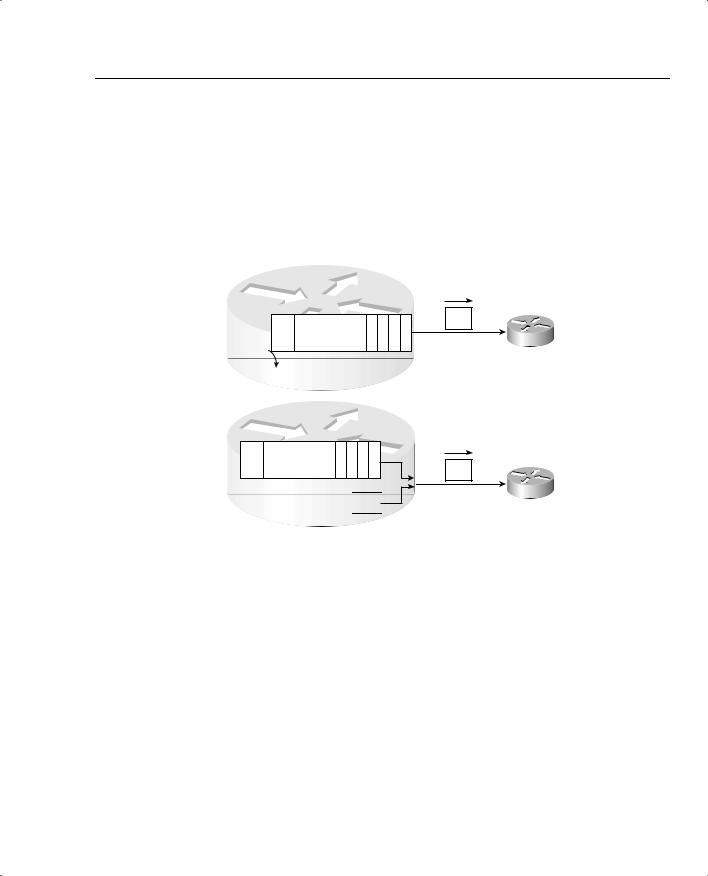
- •QoS Overview
- •“Do I Know This Already?” Quiz
- •QoS: Tuning Bandwidth, Delay, Jitter, and Loss Questions
- •Foundation Topics
- •QoS: Tuning Bandwidth, Delay, Jitter, and Loss
- •Bandwidth
- •The clock rate Command Versus the bandwidth Command
- •QoS Tools That Affect Bandwidth
- •Delay
- •Serialization Delay
- •Propagation Delay
- •Queuing Delay
- •Forwarding Delay
- •Shaping Delay
- •Network Delay
- •Delay Summary
- •QoS Tools That Affect Delay
- •Jitter
- •QoS Tools That Affect Jitter
- •Loss
- •QoS Tools That Affect Loss
- •Summary: QoS Characteristics: Bandwidth, Delay, Jitter, and Loss
- •Voice Basics
- •Voice Bandwidth Considerations
- •Voice Delay Considerations
- •Voice Jitter Considerations
- •Voice Loss Considerations
- •Video Basics
- •Video Bandwidth Considerations
- •Video Delay Considerations
- •Video Jitter Considerations
- •Video Loss Considerations
- •Comparing Voice and Video: Summary
- •IP Data Basics
- •Data Bandwidth Considerations
- •Data Delay Considerations
- •Data Jitter Considerations
- •Data Loss Considerations
- •Comparing Voice, Video, and Data: Summary
- •Foundation Summary
- •QoS Tools and Architectures
- •“Do I Know This Already?” Quiz
- •QoS Tools Questions
- •Differentiated Services Questions
- •Integrated Services Questions
- •Foundation Topics
- •Introduction to IOS QoS Tools
- •Queuing
- •Queuing Tools
- •Shaping and Policing
- •Shaping and Policing Tools
- •Congestion Avoidance
- •Congestion-Avoidance Tools
- •Call Admission Control and RSVP
- •CAC Tools
- •Management Tools
- •Summary
- •The Good-Old Common Sense QoS Model
- •GOCS Flow-Based QoS
- •GOCS Class-Based QoS
- •The Differentiated Services QoS Model
- •DiffServ Per-Hop Behaviors
- •The Class Selector PHB and DSCP Values
- •The Assured Forwarding PHB and DSCP Values
- •The Expedited Forwarding PHB and DSCP Values
- •The Integrated Services QoS Model
- •Foundation Summary
- •“Do I Know This Already?” Quiz Questions
- •CAR, PBR, and CB Marking Questions
- •Foundation Topics
- •Marking
- •IP Header QoS Fields: Precedence and DSCP
- •LAN Class of Service (CoS)
- •Other Marking Fields
- •Summary of Marking Fields
- •Class-Based Marking (CB Marking)
- •Network-Based Application Recognition (NBAR)
- •CB Marking show Commands
- •CB Marking Summary
- •Committed Access Rate (CAR)
- •CAR Marking Summary
- •Policy-Based Routing (PBR)
- •PBR Marking Summary
- •VoIP Dial Peer
- •VoIP Dial-Peer Summary
- •Foundation Summary
- •Congestion Management
- •“Do I Know This Already?” Quiz
- •Queuing Concepts Questions
- •WFQ and IP RTP Priority Questions
- •CBWFQ and LLQ Questions
- •Comparing Queuing Options Questions
- •Foundation Topics
- •Queuing Concepts
- •Output Queues, TX Rings, and TX Queues
- •Queuing on Interfaces Versus Subinterfaces and Virtual Circuits (VCs)
- •Summary of Queuing Concepts
- •Queuing Tools
- •FIFO Queuing
- •Priority Queuing
- •Custom Queuing
- •Weighted Fair Queuing (WFQ)
- •WFQ Scheduler: The Net Effect
- •WFQ Scheduling: The Process
- •WFQ Drop Policy, Number of Queues, and Queue Lengths
- •WFQ Summary
- •Class-Based WFQ (CBWFQ)
- •CBWFQ Summary
- •Low Latency Queuing (LLQ)
- •LLQ with More Than One Priority Queue
- •IP RTP Priority
- •Summary of Queuing Tool Features
- •Foundation Summary
- •Conceptual Questions
- •Priority Queuing and Custom Queuing
- •CBWFQ, LLQ, IP RTP Priority
- •Comparing Queuing Tool Options
- •“Do I Know This Already?” Quiz
- •Shaping and Policing Concepts Questions
- •Policing with CAR and CB Policer Questions
- •Shaping with FRTS, GTS, DTS, and CB Shaping
- •Foundation Topics
- •When and Where to Use Shaping and Policing
- •How Shaping Works
- •Where to Shape: Interfaces, Subinterfaces, and VCs
- •How Policing Works
- •CAR Internals
- •CB Policing Internals
- •Policing, but Not Discarding
- •Foundation Summary
- •Shaping and Policing Concepts
- •“Do I Know This Already?” Quiz
- •Congestion-Avoidance Concepts and RED Questions
- •WRED Questions
- •FRED Questions
- •Foundation Topics
- •TCP and UDP Reactions to Packet Loss
- •Tail Drop, Global Synchronization, and TCP Starvation
- •Random Early Detection (RED)
- •Weighted RED (WRED)
- •How WRED Weights Packets
- •WRED and Queuing
- •WRED Summary
- •Flow-Based WRED (FRED)
- •Foundation Summary
- •Congestion-Avoidance Concepts and Random Early Detection (RED)
- •Weighted RED (WRED)
- •Flow-Based WRED (FRED)
- •“Do I Know This Already?” Quiz
- •Compression Questions
- •Link Fragmentation and Interleave Questions
- •Foundation Topics
- •Payload and Header Compression
- •Payload Compression
- •Header Compression
- •Link Fragmentation and Interleaving
- •Multilink PPP LFI
- •Maximum Serialization Delay and Optimum Fragment Sizes
- •Frame Relay LFI Using FRF.12
- •Choosing Fragment Sizes for Frame Relay
- •Fragmentation with More Than One VC on a Single Access Link
- •FRF.11-C and FRF.12 Comparison
- •Foundation Summary
- •Compression Tools
- •LFI Tools
- •“Do I Know This Already?” Quiz
- •Foundation Topics
- •Call Admission Control Overview
- •Call Rerouting Alternatives
- •Bandwidth Engineering
- •CAC Mechanisms
- •CAC Mechanism Evaluation Criteria
- •Local Voice CAC
- •Physical DS0 Limitation
- •Max-Connections
- •Voice over Frame Relay—Voice Bandwidth
- •Trunk Conditioning
- •Local Voice Busyout
- •Measurement-Based Voice CAC
- •Service Assurance Agents
- •SAA Probes Versus Pings
- •SAA Service
- •Calculated Planning Impairment Factor
- •Advanced Voice Busyout
- •PSTN Fallback
- •SAA Probes Used for PSTN Fallback
- •IP Destination Caching
- •SAA Probe Format
- •PSTN Fallback Scalability
- •PSTN Fallback Summary
- •Resource-Based CAC
- •Resource Availability Indication
- •Gateway Calculation of Resources
- •RAI in Service Provider Networks
- •RAI in Enterprise Networks
- •RAI Operation
- •RAI Platform Support
- •Cisco CallManager Resource-Based CAC
- •Location-Based CAC Operation
- •Locations and Regions
- •Calculation of Resources
- •Automatic Alternate Routing
- •Location-Based CAC Summary
- •Gatekeeper Zone Bandwidth
- •Gatekeeper Zone Bandwidth Operation
- •Single-Zone Topology
- •Multizone Topology
- •Zone-per-Gateway Design
- •Gatekeeper in CallManager Networks
- •Zone Bandwidth Calculation
- •Gatekeeper Zone Bandwidth Summary
- •Integrated Services / Resource Reservation Protocol
- •RSVP Levels of Service
- •RSVP Operation
- •RSVP/H.323 Synchronization
- •Bandwidth per Codec
- •Subnet Bandwidth Management
- •Monitoring and Troubleshooting RSVP
- •RSVP CAC Summary
- •Foundation Summary
- •Call Admission Control Concepts
- •Local-Based CAC
- •Measurement-Based CAC
- •Resources-Based CAC
- •“Do I Know This Already?” Quiz
- •QoS Management Tools Questions
- •QoS Design Questions
- •Foundation Topics
- •QoS Management Tools
- •QoS Device Manager
- •QoS Policy Manager
- •Service Assurance Agent
- •Internetwork Performance Monitor
- •Service Management Solution
- •QoS Management Tool Summary
- •QoS Design for the Cisco QoS Exams
- •Four-Step QoS Design Process
- •Step 1: Determine Customer Priorities/QoS Policy
- •Step 2: Characterize the Network
- •Step 3: Implement the Policy
- •Step 4: Monitor the Network
- •QoS Design Guidelines for Voice and Video
- •Voice and Video: Bandwidth, Delay, Jitter, and Loss Requirements
- •Voice and Video QoS Design Recommendations
- •Foundation Summary
- •QoS Management
- •QoS Design
- •“Do I Know This Already?” Quiz
- •Foundation Topics
- •The Need for QoS on the LAN
- •Layer 2 Queues
- •Drop Thresholds
- •Trust Boundries
- •Cisco Catalyst Switch QoS Features
- •Catalyst 6500 QoS Features
- •Supervisor and Switching Engine
- •Policy Feature Card
- •Ethernet Interfaces
- •QoS Flow on the Catalyst 6500
- •Ingress Queue Scheduling
- •Layer 2 Switching Engine QoS Frame Flow
- •Layer 3 Switching Engine QoS Packet Flow
- •Egress Queue Scheduling
- •Catalyst 6500 QoS Summary
- •Cisco Catalyst 4500/4000 QoS Features
- •Supervisor Engine I and II
- •Supervisor Engine III and IV
- •Cisco Catalyst 3550 QoS Features
- •Cisco Catalyst 3524 QoS Features
- •CoS-to-Egress Queue Mapping for the Catalyst OS Switch
- •Layer-2-to-Layer 3 Mapping
- •Connecting a Catalyst OS Switch to WAN Segments
- •Displaying QoS Settings for the Catalyst OS Switch
- •Enabling QoS for the Catalyst IOS Switch
- •Enabling Priority Queuing for the Catalyst IOS Switch
- •CoS-to-Egress Queue Mapping for the Catalyst IOS Switch
- •Layer 2-to-Layer 3 Mapping
- •Connecting a Catalyst IOS Switch to Distribution Switches or WAN Segments
- •Displaying QoS Settings for the Catalyst IOS Switch
- •Foundation Summary
- •LAN QoS Concepts
- •Catalyst 6500 Series of Switches
- •Catalyst 4500/4000 Series of Switches
- •Catalyst 3550/3524 Series of Switches
- •QoS: Tuning Bandwidth, Delay, Jitter, and Loss
- •QoS Tools
- •Differentiated Services
- •Integrated Services
- •CAR, PBR, and CB Marking
- •Queuing Concepts
- •WFQ and IP RTP Priority
- •CBWFQ and LLQ
- •Comparing Queuing Options
- •Conceptual Questions
- •Priority Queuing and Custom Queuing
- •CBWFQ, LLQ, IP RTP Priority
- •Comparing Queuing Tool Options
- •Shaping and Policing Concepts
- •Policing with CAR and CB Policer
- •Shaping with FRTS, GTS, DTS, and CB Shaping
- •Shaping and Policing Concepts
- •Congestion-Avoidance Concepts and RED
- •WRED
- •FRED
- •Congestion-Avoidance Concepts and Random Early Detection (RED)
- •Weighted RED (WRED)
- •Flow-Based WRED (FRED)
- •Compression
- •Link Fragmentation and Interleave
- •Compression Tools
- •LFI Tools
- •Call Admission Control Concepts
- •Local-Based CAC
- •Measurement-Based CAC
- •Resources-Based CAC
- •QoS Management Tools
- •QoS Design
- •QoS Management
- •QoS Design
- •LAN QoS Concepts
- •Catalyst 6500 Series of Switches
- •Catalyst 4500/4000 Series of Switches
- •Catalyst 3550/3524 Series of Switches
- •Foundation Topics
- •QPPB Route Marking: Step 1
- •QPPB Per-Packet Marking: Step 2
- •QPPB: The Hidden Details
- •QPPB Summary
- •Flow-Based dWFQ
- •ToS-Based dWFQ
- •Distributed QoS Group–Based WFQ
- •Summary: dWFQ Options

QoS: Tuning Bandwidth, Delay, Jitter, and Loss 29
Loss
The last QoS traffic characteristic is packet loss, or just loss. Routers lose/drop/discard packets for many reasons, most of which QoS tools can do nothing about. For instance, frames that fail the incoming frame check sequence (FCS) are discarded—period. However, QoS tools can be used to minimize the impact of packets lost due to full queues.
In most networks today, the number of packets lost due to bit errors is small, typically less than one in one billion (bit error rate [BER] of 10–9 or better). Therefore, the larger concern for packet loss is loss due to full buffers and queues. Consider Figure 1-15, with Hannah sending 50 consecutive 1500-byte packets, and R1 having a queue of size 40.
Figure 1-15 50 Packets Sent, Only 40 Slots in the Queue
R1
|
|
Packets 1-40 Find |
|
FIFO Output Queue |
|||||||
50 x 1500 Byte Packets, |
Space in the Queue |
40 |
|
............ |
4 |
3 |
2 |
1 |
56-kbps Link |
||
from Various Hosts |
|
|
|||||||||
|
|||||||||||
|
|
|
|
||||||||
|
|
|
|
|
|
|
|
|
|
|
|
Packets 41-50 to Bit Bucket
The term “tail drop” refers to when a router drops a packet when it wants to put the packet at the end or the tail of the queue. As Figure 1-15 shows, when all 40 queue slots are filled, the rest of the 50 packets are dropped. In a real network, a few of the packets might be sent out the serial link before all 50 packets are received, so maybe not all 10 packets are lost, but certainly a large number of packets would be lost.
Some flows tolerate loss better than others do. For instance, the human ear can detect loss of only 10 ms of voice, but the listener can generally understand speech with such small loss. Cisco digital signal processors (DSPs) can predict the contents of lost voice packets, up to 30 ms when using the G.729 codec. By default, each voice packet contains 20 ms of voice; so if two consecutive voice packets are lost, the DSP cannot re-create the voice, and the receiver can actually perceive the silence. Conversely, web traffic tolerates loss well, using TCP to recover the data.
QoS Tools That Affect Loss
Only a few QoS features can help with packet loss issues. You’ll find more detail about each of these tools in various chapters throughout this book. For now, however, knowing what each class of QoS tool accomplishes will help you sift through some of the details.

30 Chapter 1: QoS Overview
By now, you should guess that bandwidth will help prevent lost packets. More bandwidth helps—it just does not solve all problems. And frankly, if all you do is add more bandwidth, and you have a converged voice/video/data network, you will still have quality issues.
How does more bandwidth reduce loss? More bandwidth allows packets to be transmitted faster, which reduces the length of queues. With shorter queues, the queues are less likely to fill. Unless queues fill, packets are not tail dropped.
You can use one class of tool to help reduce the impacts of loss. This class is called Random Early Detection.
Random Early Detection (RED)
TCP uses a windowing protocol, which restricts the amount of data a TCP sender can send without an acknowledgment. Each TCP window for each different TCP connection grows and shrinks based on many factors. RED works under the assumption that if some of the TCP connections can be made to shrink their windows before output queues fill, the collective number of packets sent into the network will be smaller, and the queue will not fill. During times when the queues are not getting very full, RED does not bother telling the TCP senders to slow down, because there is no need to slow down.
RED just discards some packets before a queue gets full and starts to tail drop. You can almost think of RED tools as managing the end of a queue, while the queuing tool manages the front of the queue! Because most traffic is TCP based and TCP slows down sending packets after a earlier packet is lost, RED reduces the load of packets that are entering the network before the queues fill. RED requires a fairly detailed explanation for a true understanding of what it does, and how it works. However, the general idea can be easily understood, as long as you know that TCP will slow down sending, by reducing its window size, when packets are lost.
TCP uses a window, which defines how much data can be sent before an acknowledgment is received. The window changes size dynamically, based on several factors, including lost packets. When packets are lost, depending on other conditions, a TCP window shrinks to 50 percent of the previous window size. With most data traffic being TCP in a typical network, when a large amount of tail drop occurs, almost all, if not all TCP connections sending packets across that link have their TCP windows shrunk by 50 percent at least once.
Consider the example in Figure 1-15. As that figure shows, 50 packets were sent, and the queue filled, and 10 of those packets were lost. If those 50 packets were part of 10 different TCP connections, and all 10 connections lost packets in the big tail drop, the next time the hosts send, only 25 total packets would be sent (windows all cut in half).
With RED, before tail drop occurs, RED discards some packets, forcing only a few of the TCP connections to slow down. By allowing only a few of the TCP windows to be reduced, tail drops can be avoided, and most users get better response time. The collective TCP sending rate stabilizes to a level for which tail drops seldom if ever occur. For those TCP connections for

QoS: Tuning Bandwidth, Delay, Jitter, and Loss 31
which RED dropped packets, response time is temporarily slow. However, that is much better than all users experiencing slow response time!
Queuing accomplishes a lot of tasks—including reducing loss. Because loss occurs when queues fill, and because the queuing methods typically provide the ability to configure the maximum queue size, you can just make the queue longer. With a longer maximum queue size, likelihood of loss decreases. However, queuing delay increases. Consider, for instance, Figure 1-16.
Figure 1-16 Queuing Affects on Packet Loss
Single FIFO Queue—
Max Size 50
............
Tail Drop
Queue1—Size 50—
Less Loss, More Latency
............
Queue2—Size 5—
More Loss, Less Latency 


In the top example, a single FIFO queue is used. For delay-sensitive traffic, waiting behind 49 other packets might not work well. For applications that are loss sensitive, but not as delay sensitive, however, a long queue might work better. One goal might be to put delay-sensitive traffic into a different queue from loss-sensitive traffic, with an extra-long queue length for the loss-sensitive traffic, as shown in the bottom part of the figure. As usual, a tradeoff occurs—in this case, between low loss and low delay.
Table 1-9 summarizes the points concerning the two types of QoS tools that affect loss.
Table 1-9 QoS Tools That Affect Loss
Type of QoS Tool |
Brief Description |
|
|
Queuing |
Implementing longer queues increases delay, but avoids loss. |
|
|
RED |
Implementing RED drops packets randomly as queues approach the point of |
|
being full, slowing some TCP connections. This reduces overall load, shorten- |
|
ing the congested queue, while affecting only some user’s response times. |
|
|
